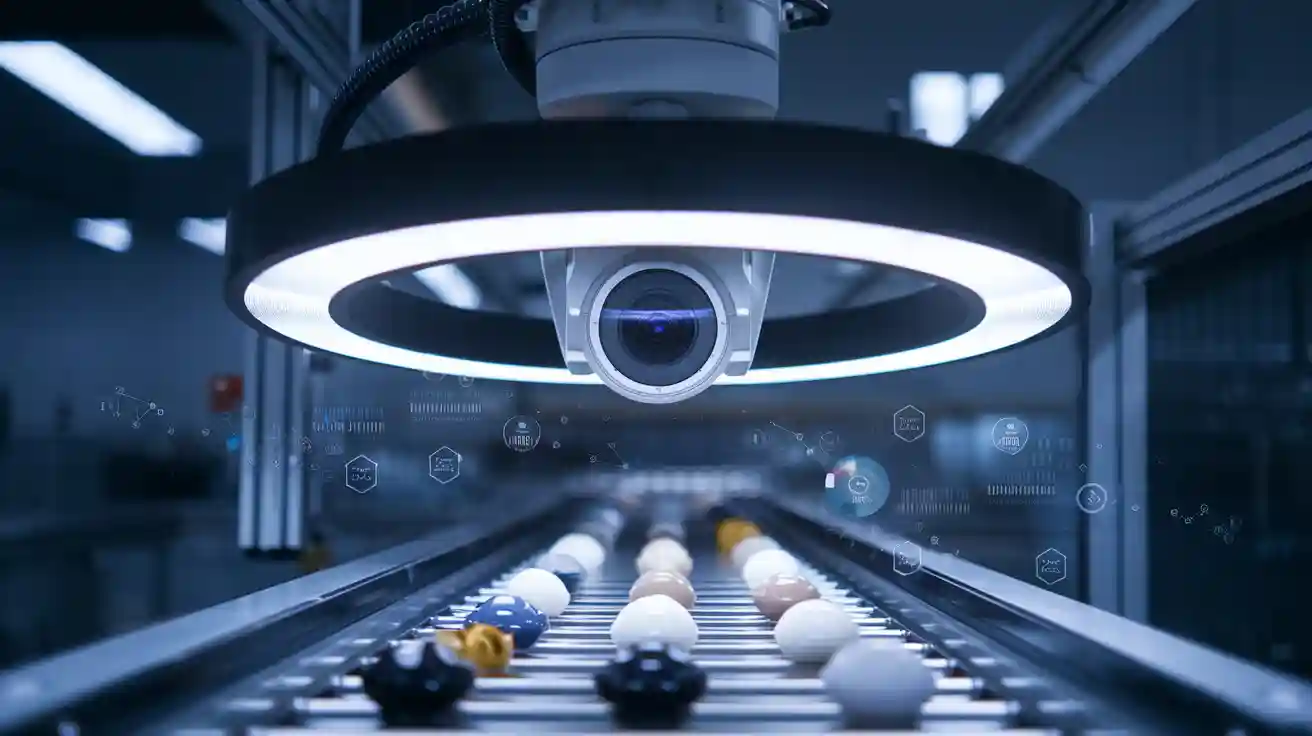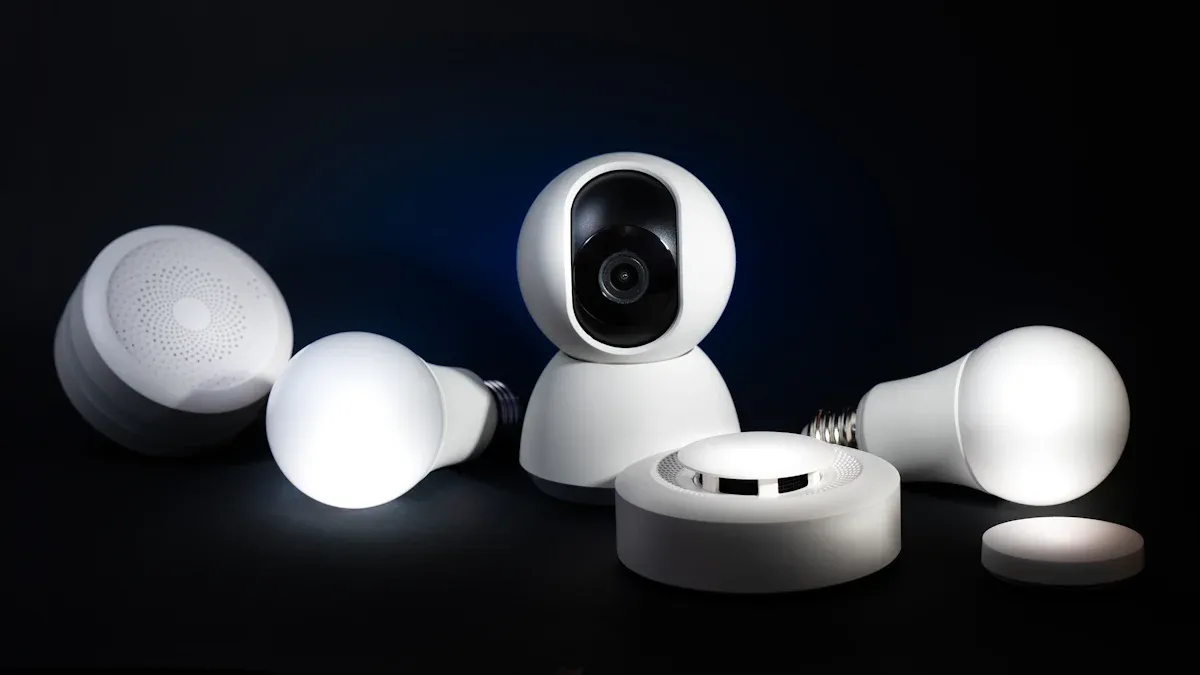
A ring light machine vision system uses a circular arrangement of LEDs to provide even, shadow-free illumination for cameras in machine vision lighting. This system stands out because it can produce different lighting effects—such as darkfield, bright field, or diffused light—by changing the angle and type of LEDs. The importance of lighting becomes clear in tasks where shadows can hide defects or features. Many machine vision applications, including quality control or inspection, rely on the ring light machine vision system for consistent results.
- Common uses include:
- Quality control
- Robotics
- Pick-and-place
- Inspection tasks
Key Takeaways
- Ring light machine vision systems provide even, shadow-free lighting that helps cameras capture clear and accurate images for inspection.
- The circular LED design allows ring lights to highlight surface defects and textures by adjusting light angles and types.
- Ring lights are flexible and easy to integrate with many cameras, offering adjustable brightness, colors, and mounting options.
- Compared to other lighting types, ring lights excel at close-up inspections of small or reflective objects with uniform illumination.
- Using ring lights improves inspection accuracy, reduces errors, and supports fast, reliable quality control in various industries.
Ring Light Machine Vision System

Definition
A ring light machine vision system uses a circular array of LEDs that surrounds the camera lens. This design creates even, direct lighting that reduces shadows and highlights important features on the object being inspected. The ring light setup allows the camera to capture clear images by providing consistent illumination from all directions. This system stands out among the types of machine vision systems because it delivers uniform lighting, which is essential for accurate inspection and measurement tasks.
Ring lights can adapt to different lighting techniques. For example, they can provide bright field lighting by placing the LEDs at angles between 45° and 90° to the surface. They can also create dark field lighting by positioning the LEDs at lower angles, between 0° and 45°, which helps reveal surface defects or scratches. The flexibility of the ring light machine vision system makes it suitable for many inspection environments.
Core Components
A ring light machine vision system includes several key parts that work together to deliver high-quality images. The main components are:
| Component | Description |
|---|---|
| Image Sensor | Converts light into electrical signals; core of the vision system; uses CCD or CMOS technology. |
| Lens | Collects and focuses light onto the image sensor; types include manual, autofocus, and liquid lenses. |
| Cover | Protects the camera from environmental hazards like dust, water, and impacts; often rated IP67. |
| Processor | Processes image data; can be onboard or external; supports rule-based, edge learning, or deep learning algorithms. |
The ring-shaped LED array is the heart of the lighting system. It surrounds the lens and provides on-axis illumination, which means the light comes from the same direction as the camera’s view. This setup minimizes shadows and ensures that the lighting remains stable and uniform. Many ring lights also use diffusers to soften the light, reduce glare, and prevent hotspots, which is especially important when inspecting shiny or reflective surfaces.
💡 Tip: The modular design of ring lights allows users to choose different sizes, brightness levels, and colors. This adaptability helps the system meet the needs of various inspection tasks, from electronics to medical devices.
Purpose in Machine Vision Lighting
The main purpose of a ring light machine vision system is to provide uniform, diffuse illumination around the camera lens. This type of lighting improves the visibility of features on the object by reducing shadows and creating consistent lighting conditions. Uniform lighting is critical for machine vision lighting because it ensures that the camera captures accurate and reliable images for inspection.
Ring lights excel at bright field lighting, which enhances the contrast of features and makes defects easier to spot. When used at low angles, ring lights can also create dark field effects, which highlight surface scratches, stains, or other small defects. This versatility allows the ring light machine vision system to adapt to different inspection needs and working distances.
Recent advancements in ring lights include miniaturization for use in tight spaces, higher brightness for better inspection precision, and smart features for easy integration with modern machine vision lighting systems. Adjustable color temperatures and improved energy efficiency also help ring lights meet the demands of today’s automated factories.
How Ring Lights Work
Design and Structure
Ring lights use a circular geometry that surrounds the camera lens. This design provides low to medium angle illumination close to the target. The circular shape ensures 360-degree uniform lighting, which reduces shadows and enhances contrast. Many ring lights use Chip-on-Board (COB) LED technology. This allows for a high density of LEDs in a compact form. The result is powerful and even illumination. Good thermal management and easy installation help maintain consistent light output and extend the lifespan of the lighting system. Diffuse ring lights include special elements that soften the light, which helps minimize glare on shiny or curved surfaces. This structure supports high-quality image capture in machine vision applications.
Lighting Configurations
Ring lights offer several lighting configurations to suit different inspection needs:
- Circular directional (partial bright field) lighting highlights features on mirrored or reflective surfaces.
- Circular dark field lighting uses low or medium angles to enhance edges and defects by reflecting light away from the camera except at feature edges.
- Diffuse dome lighting provides even, multidirectional illumination, which works well for curved or specular surfaces.
- On-axis diffuse lighting delivers uniform light coaxial to the camera, making it effective for flat samples and textured features.
These configurations allow users to select the best lighting for each inspection task. Proper lighting optimization ensures accurate results.
Use in Machine Vision Applications
Ring lights play a key role in many machine vision applications. The ring light setup surrounds the part being inspected, providing even illumination from all directions. This arrangement minimizes shadows and improves image contrast. Ring lights work well for inspecting matte, reflective, or flat surfaces. They help detect surface defects such as scratches, dents, and texture changes. Polarizing filters can reduce reflections on flat surfaces, improving image clarity. However, polarizers may lower light intensity and work less effectively on curved surfaces. Ring lights also support object recognition, classification, and dimension measurement. Their uniform lighting makes them ideal for close-up imaging and defect detection, where high light intensity and minimal shadows are critical.
Benefits of Ring Lights
Uniform Illumination
Uniform illumination stands as one of the key benefits of ring lights in machine vision. The ring-shaped design places LEDs around the camera lens. This setup directs light evenly onto the object from all sides. The importance of lighting becomes clear when inspecting surfaces for small defects or changes in texture. Ring lights achieve uniform illumination by using the right size and LED orientation. The ring must be larger than the field-of-view to cover the entire area. Bright-field ring lights have LEDs pointing straight at the object, while dark-field types aim the LEDs at an angle. This approach creates a smooth, even light that covers the whole surface.
Other lighting solutions, such as spotlights, often create bright spots and dark areas. Dome lights and coaxial diffuse lights need to be much larger and closer to the part to match the uniformity of ring lights. Some setups use four bar lights arranged in a ring, but this method can be less flexible. The combination of ring geometry and LED placement makes ring lights a common choice for tasks that demand uniform illumination.
Note: Uniform illumination helps cameras capture clear images without bright spots or shadows. This improves the accuracy of inspections and measurements.
Shadow-Free Imaging
Shadow-free imaging is another major advantage of ring lights. The circular arrangement of LEDs surrounds the camera lens and shines light directly onto the object. This design reduces shadows and provides even lighting. Consistent illumination supports reliable surface inspection and helps the camera detect small defects.
- Ring lights fit easily into machine vision setups and provide steady lighting.
- They work in bright field mode to highlight flat surfaces or in dark field mode to reveal scratches and dents.
- Combining ring lights with dome lights can create even more uniform illumination, especially for complex shapes.
- Proper lighting from ring lights reduces shadow effects that can lower image quality.
- Shadowless ring lights help achieve high classification accuracy by removing glare and making defects easier to see.
Real-world examples show how shadow-free imaging improves production line inspection. For instance, low-angle dark field ring lights highlight contours and joints on battery components. This makes it easier to spot defects. In steel coil inspection, a ring light with polarized filters helps detect micro-cracks and scratches on shiny metal. The system runs at high speeds and maintains over 98% accuracy in real-time edge defect detection.
Flexibility and Integration
Ring lights offer great flexibility and easy integration with many machine vision cameras and systems. Users can choose from different mounting options, such as step-up or step-down rings, T-slot mounts, or threaded holes. This allows the lighting to fit many setups. Ring lights also support a wide range of lens sizes and camera models. Adapter rings make it simple to match the lighting to the camera.
| Feature Category | Details |
|---|---|
| Mounting Options | Step-up/step-down rings, T-slot mounting, threaded M4 holes |
| Compatibility | Fits all CCTV lens models, adapter rings for all lens sizes |
| Light Output Options | White, Red, Amber, Blue, Green, Cyan, IR, UV |
| Integrated Driver | Constant current driver, strobe input, PNP/NPN trigger control |
| Intensity Control | Analog 0-10VDC or built-in potentiometer |
| Housing | Aluminum, compact industrial housing |
| Connectivity | M12 style quick disconnect |
Ring lights come in many colors and brightness levels. Users can adjust the intensity to match the needs of each inspection. The compact design fits into tight spaces and supports close-up imaging. Integrated drivers and quick-connect cables make installation fast and simple. These features allow ring lights to work with many types of cameras and inspection systems.
💡 Tip: The flexibility of ring lights means they can adapt to new tasks as production needs change. This makes them a smart investment for factories and labs.
The importance of lighting in machine vision cannot be overstated. Ring lights provide uniform illumination, shadow-free imaging, and flexible integration. These features help improve inspection accuracy, reduce errors, and support high-speed production lines.
Comparison with Other Machine Vision Lighting

Ring Lights vs. Bar Lights
Ring lights and bar lights serve different roles in machine vision. A ring light surrounds the camera lens and delivers uniform, circular illumination. This design reduces shadows and helps cameras detect edges and small features. Bar lights, on the other hand, use a linear arrangement. A bar light setup can provide both bright-field and dark-field illumination by changing the angle of the light. This flexibility allows bar lights to highlight surface defects like scratches or dents, especially on large or moving objects.
| Lighting Type | Illumination Uniformity | Application Suitability |
|---|---|---|
| Ring Lights | Uniform, circular illumination that minimizes shadows and enhances edge detection. | Best for inspecting small, shiny, or reflective objects. Compact design fits easily into machine vision systems. |
| Bar Lights | Directional linear illumination, less uniform but covers larger or elongated areas. | Ideal for inspecting large or elongated objects, such as items on conveyor belts. Effective for detecting surface defects on moving objects. |
Ring lights work best for close-range inspection of small or symmetrical parts. Bar lights excel when inspecting larger or irregularly shaped items. A bar light setup often requires more precise alignment and calibration. Ring lights offer a simpler, more compact solution for even lighting, while bar lights provide flexibility for targeted illumination.
Tip: Choose ring lights for tasks that need concentrated, shadow-free lighting. Select bar lights for applications that require adjustable coverage and higher intensity over wide areas.
Ring Lights vs. Backlights
Ring lights and backlights use different lighting geometries. Ring lights shine from the same direction as the camera, which can sometimes cause reflections on shiny surfaces. They help detect surface flaws and highlight topographic details. Backlights, however, place the light source behind the object. This creates a silhouette effect, making it easy to see edges, holes, or the presence of features.
Backlights work well for inspecting transparent or semi-transparent materials. They reveal internal defects and provide strong contrast for shape and presence detection. For example, a backlight can expose seal imperfections in clear pouches or detect flaws inside glass. Ring lights, in contrast, focus on surface inspection and may not reveal internal issues as clearly.
Choosing the Right Lighting
Selecting the best lighting depends on several factors:
- Application Type: The shape and texture of the object matter. Flat or reflective items often benefit from ring lights. Large or elongated objects may need bar lights. Transparent materials usually require backlights.
- Light Angle and Placement: Low-angle ring lights highlight surface flaws. A bar light setup can adjust angles for bright-field or dark-field effects.
- Color (Wavelength): Different colors enhance contrast. Red works for general imaging, while blue or green can show material details.
- Brightness and Stability: Consistent, bright lighting ensures reliable inspection.
- Form Factor and Mounting: The physical shape of the light—ring, bar, or backlight—should fit the inspection system and provide the needed illumination.
A ring light offers stable, uniform lighting for many inspection tasks. Bar lights provide flexible, adjustable coverage for larger or moving parts. Backlights excel at silhouette imaging and internal defect detection. Each lighting type has strengths, so users should match the light to the inspection goal.
Ring light machine vision systems deliver uniform, shadow-free illumination that enhances image quality and defect detection. These systems provide stable, energy-efficient lighting, which supports high-speed and high-precision inspections. Industry experts recognize ring lights as essential for capturing clear, high-contrast images in both AI and traditional machine vision.
- Use ring lights for:
- Inspecting circular or cylindrical parts
- Electronics and automotive inspections
- Tasks needing consistent, repeatable results
Ring lights remain a vital choice for modern machine vision, offering reliable performance and adaptability in evolving inspection environments.
FAQ
What types of surfaces work best with ring lights in machine vision?
Ring lights work best on flat, matte, or slightly reflective surfaces. They provide even lighting, which helps cameras see small details. Shiny or curved surfaces may need extra filters or diffusers for the best results.
Can ring lights be used with any camera?
Most ring lights fit many camera types. Users can attach them with adapter rings or mounts. They work well with both industrial and scientific cameras. Always check the size and compatibility before choosing a ring light.
How do users control the brightness of a ring light?
Many ring lights have built-in controls. Users can adjust brightness with a knob or a remote. Some models support analog voltage control or digital signals for precise adjustments.
Do ring lights create heat during operation?
Ring lights use LEDs, which produce less heat than older bulbs. Good designs include heat sinks or cooling features. This keeps the light cool and safe for long use.
What is the main advantage of using a ring light for inspection?
Ring lights give uniform, shadow-free lighting. This helps cameras capture clear images. Inspectors can spot defects or measure parts more accurately. Ring lights improve quality control in many industries.
See Also
Essential Features And Advantages Of Machine Vision In Medical Devices
Understanding The Role Of Cameras In Machine Vision Systems
Why Proper Lighting Is Vital For Machine Vision Equipment
The Impact Of Structured Light On Machine Vision Performance
A Comprehensive Guide To Electronics-Based Machine Vision Systems









